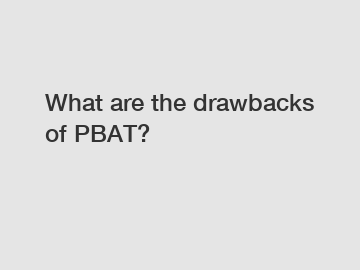What are the drawbacks of PBAT?
What are the drawbacks of PBAT?
PBAT, also known as polybutylene adipate terephthalate, is a biodegradable copolyester widely used in packaging materials, particularly in the production of biodegradable bags. Despite its environmental benefits, PBAT also has its drawbacks that require attention and consideration.
One of the main drawbacks of PBAT is its slow rate of biodegradation. While PBAT is designed to degrade under specific conditions, such as in compost facilities, it requires extensive time, often years, to fully break down. This slow rate of degradation reduces its effectiveness as a sustainable alternative to traditional plastic.

The slow biodegradation of PBAT can be attributed to its complex molecular structure. PBAT consists of two main components, polybutylene adipate (PBA) and terephthalate, which contribute to its durability and elasticity. However, these same characteristics hinder the microbial activity necessary for efficient biodegradation. The strong intermolecular forces within the polymer matrix make it difficult for microorganisms to penetrate and assimilate the material, prolonging the degradation process.
Another drawback of PBAT is its reliance on industrial composting facilities for optimal degradation. While PBAT may partially degrade in home composting systems, it requires specific conditions, such as controlled temperature, moisture, and microbial activity, that are typically only present in large-scale composting facilities. This limitation restricts the widespread use of PBAT as an environmentally friendly material, particularly in areas without access to such facilities.
Furthermore, the production of PBAT relies on the use of non-renewable resources, such as petroleum-derived monomers. Although PBAT is considered biodegradable, the extraction and production processes associated with its manufacturing contribute to carbon emissions and environmental degradation. This aspect diminishes the overall sustainability of PBAT as an alternative to conventional plastics.
The drawbacks of PBAT highlight the need for continued research and innovation in the field of biodegradable materials. Scientists are actively exploring ways to enhance the biodegradability of PBAT through modifications to its composition and structure. Additionally, efforts are being made to develop alternative biodegradable materials that overcome the limitations of PBAT.
In conclusion, while PBAT offers certain environmental advantages as a biodegradable copolyester, it is important to consider its drawbacks. The slow rate of biodegradation, reliance on industrial composting facilities, and the use of non-renewable resources in its production pose challenges to its widespread adoption. Awareness of these drawbacks encourages the pursuit of more efficient and sustainable alternatives in the realm of biodegradable materials.
Contact us to discuss your requirements of is cornstarch biodegradable, Cornstarch compostable resin, resin biodegradable supplier. Our experienced sales team can help you identify the options that best suit your needs.
51
0
0

Comments
All Comments (0)